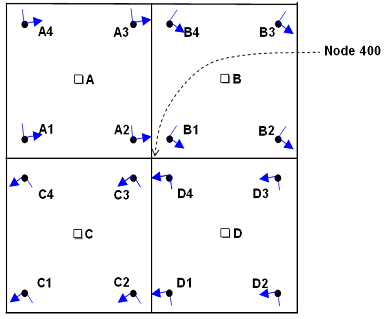Nodal Averaging of Elemental Results |

|

|

|

|
|
Nodal Averaging of Elemental Results |

|

|

|

|
Nodal averaging of elemental results at a node refers to the average of all the element corner results passing through that node. If no corner results are available for an element, centroidal results will be used calculate the nodal average. In the example figure below, four elements are passing through Node 400. The average results at Node 400 is equal to:
| when Use corner data is turned on. |
| when Use corner data is turned off. |

Nodal averaging options are selected from the Averaging method drop-down menu on the Contour and Iso panels. The options are:
Whenever the Use corner data option is activated in the Contour or Iso panels, the following averaging methods will also appear in the drop-down menu:
These methods aggregate the maximum, minimum, or extreme values of all corner values and assign that to the centroid of the element. For example, when using the Max of Corner averaging method on element A: the maximum of A1, A2, A3, A4 is assigned to the element centroid.
Two additional methods of averaging are available which will compute the maximum or minimum of the element values connecting a node:
In the example figure above, four elements are passing through Node 400. The maximum results at Node 400 is equal to:
max (A2, B1, C3, D4) |
when Use corner data is turned on. |
max (A, B, C, D) |
when Use corner data is turned off. |
| Note | Replace max with min in order to compute the minimum results at Node 400 (based on the example figure above). |
See also